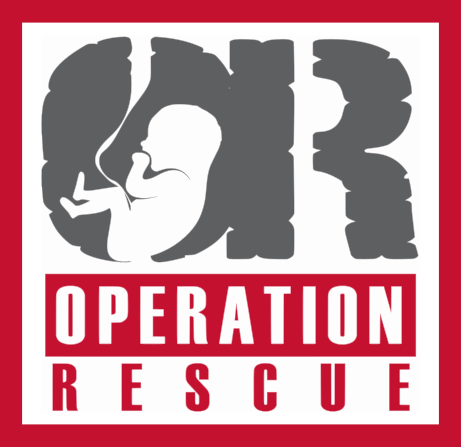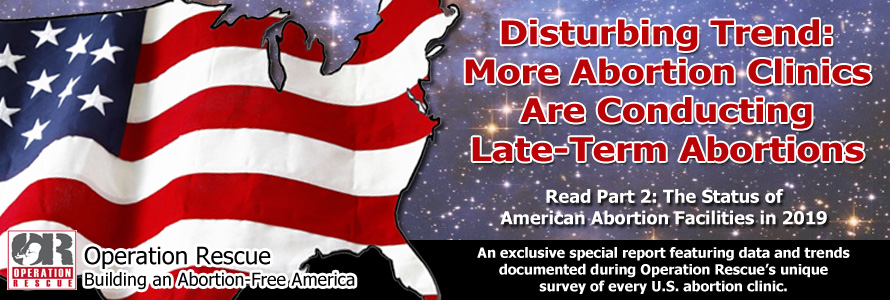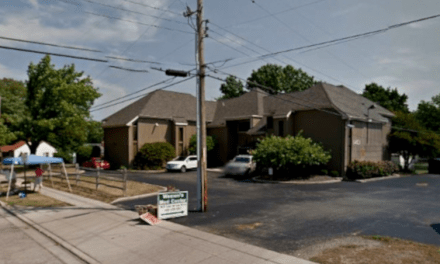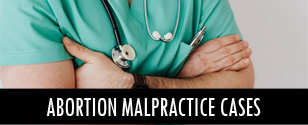The Status of American Abortion Facilities in 2019
PART TWO OF A TWO-PART OPERATION RESCUE SPECIAL REPORT
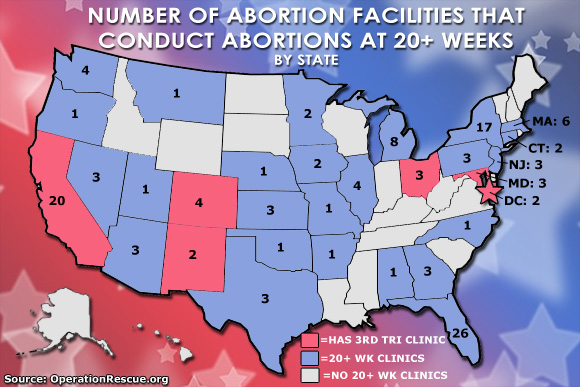
By Cheryl Sullenger
A new survey of abortion facilities in the U.S. has revealed a new, disturbing industry-wide trend that shows that overall in 2019, surgical abortion facilities have expanded into the late-term abortion market, where lucrative multi-day procedures can reap quick profits.
The survey also found the following:
- There are 710 abortion facilities in the U.S., comprised of 464 surgical and 245 medical abortion clinics.
- The percentage of surgical abortion facilities that self-impose abortion limits at 13 weeks or earlier dropped from 46% in 2018 to 31% in 2019, meaning more are entering the second and even third-trimester abortion markets.
- The number of abortion facilities willing to do abortions after 20 weeks gestation increased in 2019.
- The national average cost of a first-trimester abortion rose to a record high of $603 in 2019, the greatest increase in three years.
- The national average wait time for abortion appointments remains under a week at 6.8 days, which is more than two weeks less than it takes to arrange a first appointment with a family physician.
“Much of the data gathered during our survey this year either debunks pro-abortion rhetoric or red-flags dangerous trends,” said Troy Newman, President of Operation Rescue. “We see women being exploited by rising prices and a rush to get abortions done. We also see abortion becoming riskier with the new push into dangerous late-term abortions. This information exposes areas where more can be done to save lives.”
Methodology
Each year, Operation Rescue conducts a nationwide survey that involves contact with each abortion business in the U.S. The information gathered about the abortion clinics and their practices represents the most accurate data available.
This most recent data was compiled by Operation Rescue, which conducted a survey of all abortion facilities in the U.S. from November 18 through December 6, 2019.
Operation Rescue defines “abortion clinics” as those businesses that conduct abortions outside a hospital setting. There are two categories of abortion clinics:
- Surgical Abortion Clinics: These offices conduct surgical abortions. Almost always, surgical facilities also distribute abortion-inducing drugs.
- Medical Abortion Clinics: These offices supply abortions through the administration of drugs (pills) or other chemical means. They do not conduct surgical abortions.
Gestational Age Limits
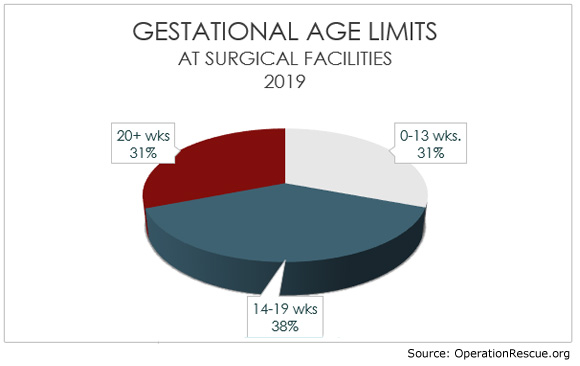
While most states set gestational limits for abortions, each abortion facility has its own self-imposed limit on how far into a pregnancy they are willing to conduct an abortion.
Because of the nature of chemical abortions, facilities that offer only that option limit abortions to 11 weeks or less.
But the number of surgical abortion facilities willing to push beyond the first trimester is on the rise.
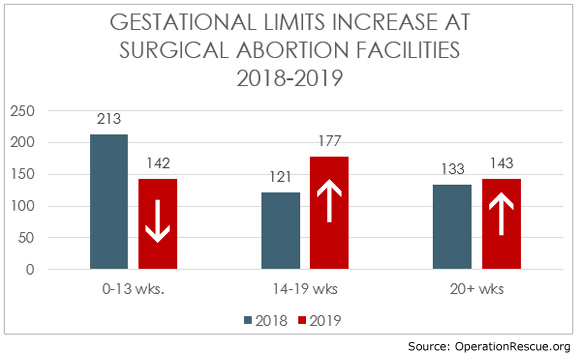
In 2018, 46% of all surgical abortion facilities set an abortion limit of 13 weeks or under. However, in 2019, only 31% of all surgical abortion facilities restricted themselves to the first trimester of pregnancy.
Surgical abortion clinics that set self-imposed abortion limits between 14-19 weeks gestation rose by 46 percent* in 2019, while clinics that now conduct abortions at 20 weeks or more rose by 8 percent.*
Currently, there are 143 surgical abortion facilities that will conduct abortions at 20 weeks or more.

Over the past ten years, the number of abortion facilities that are willing to openly conduct abortions into the third trimester of pregnancy starting at 28 weeks changed little – until 2019 when the number jumped from six to eight.
Planned Parenthood’s number of facilities that will do abortions at 20 weeks or higher dropped by two clinics in 2019, while independent abortion facilities that will do these dangerous and controversial abortions added a dozen locations.
This indicates that Planned Parenthood is more interested in expanding into the early-term medical abortion market than into the lucrative but risky late-term abortion market.
In fact, Planned Parenthood dominates in ownership of clinics that only offer abortions through chemical means, operating 211 out of the 246 such clinic now open.
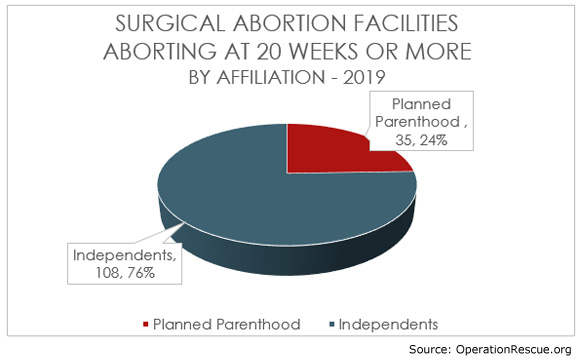
While some of these facilities are very open about having no gestational limits for abortions, others may state limits under the third trimester of pregnancy. However, since these will conduct abortions later for “fetal indications” or other so-called “medical” reasons, this essentially strips away all stated gestational limits.
Those clinics include:
- Boulder Abortion Clinic in Boulder, Colorado.
- Stated limit: As high as needed. Owner: Warren Hern.
- Capital Women’s Services in Washington, D.C.
- Stated limit: 36 weeks. Stake Holder: Steven Chase Brigham.
- CARE (Formerly AbortionClinics.org) in Bethesda, Maryland.
- Stated limit: 35 weeks. Owner: LeRoy Carhart.
- Pro-Choice Center in Beverly Hills, California.
- Stated limit: None. Owner: Josepha Seletz.
- Southwestern Women’s Options in Albuquerque, New Mexico.
- Stated limit: None. Owner: Curtis Boyd.
- Washington Surgi-Clinic
- Stated limit: 28 weeks. Owner: Cesare Santangelo.
- Women’s Med Center in Dayton, Ohio.
- Stated limit: 22 weeks. Owner: Martin Haskell.
- DuPont Clinic, Washington, D.C.
- Stated limit: None. Operators: Matthew Reaves, Stacey Rubin, & Jessica Kuperstock
First Trimester Abortion Costs
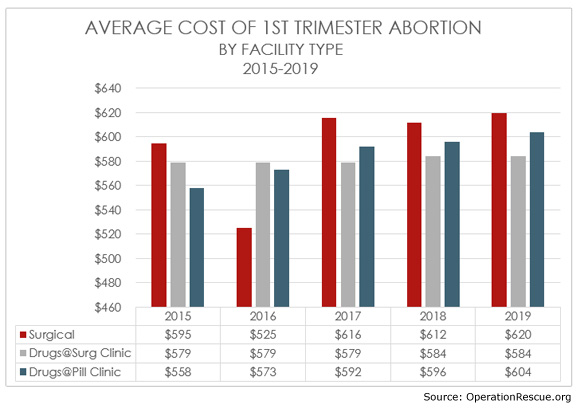
According to the Centers for Disease Control, in 2016, the most recent year with data available, 91% of all abortions take place in the first trimester of pregnancy, at or below 13 weeks gestation.
The national average cost of a first trimester abortion in 2019 was $603.
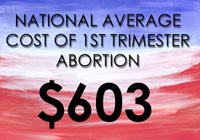
The cost of a first trimester abortion has steadily risen over the past five years when the national average cost was $577 — $26 less than 2019.
The cost of an abortion varied by type of abortion and by kind of facility. The average cost of a surgical abortion was $620.
Chemical abortions at surgical abortion facilities nationwide averaged $584. However, abortion drugs at a clinic that only offer chemical abortions was higher at an average of $604.
The fact that abortion drugs obtained at non-surgical abortion facilities are more expensive than the same drugs dispensed by a surgical abortion facility is an interesting one, especially since it is less expensive to operate a pill clinic because it does not have to be equipped to conduct surgeries and needs no surgically trained staff which might require higher salaries.
Only speculative explanations exist for this price inconsistency.
The state with the highest cost of a first trimester surgical abortion is Wyoming at $1099, while the state with the highest average price for abortion-inducing drugs is Colorado at $858.


North Carolina came in as the state with the lowest average cost for a first trimester surgical abortion at $408. Nebraska held the distinction of having the least expensive medical abortions. Its three abortion facilities average just $287 for abortion drugs.
Wait times for appointments
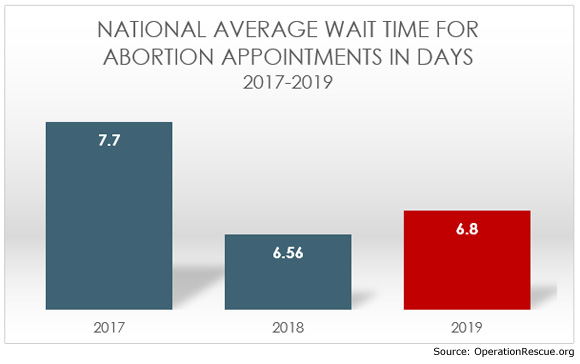
It is not unusual to hear news reports about how women must wait weeks to get an abortion appointment due to the passage of pro-life laws.
This is just not true.
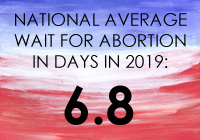
The national average time a woman must wait for an abortion is 6.8 days – under a week. This time is measured from the day a woman picks up the phone to make an appointment to the day of her actual abortion procedure. It includes a first appointment and state-mandated reflection times of 24-72 hours.
In contrast, one 2017 report notes that nationally it takes an average of 24 days to get an appointment with a family physician, between 12 and 51 days to get an appointment with an obstetrician, and 32.2 days to get an appointment with a dermatologist.
“Because we obtained data from every abortion facility in the U.S., we know that this is the most accurate data out there on actual abortion wait times,” said Newman. “News reports that say women have to wait weeks for abortion appointments are nothing but fake news that is meant to manipulate public opinion against pro-life laws.”
Conclusions
Late-term abortions
Abortion facilities are seeking to replace lost income due to decreased demand for abortion. One way to increase profits is to expand into the second and third trimester abortion market where clinics have been known to charge over $20,000 for the latest of abortions.
“It takes a lot of 600-dollar abortions to earn what they can charge for one third trimester abortion,” said Newman. “When expanding into late-term abortions becomes a quick way to make a lot of money, it becomes a predatory practice. Late-term abortions pose grave dangers to women. As the pregnancy progresses, the risks of life-threatening complications or death go up with it.”
Until a complete ban on all abortions can be accomplished, Operation Rescue supports gestational limits on abortions.
Profit-taking
The increase in abortion costs is reflective of what a woman would pay out of her pocket. However, many clinics operate on a sliding scale or can bill insurance to cover part of the costs. Many abortion businesses also receive subsidies from the federal and state governments, along with reimbursements from private abortion funds. This allows abortion clinics to raise prices and profits, while not driving away customers.
“We are thankful that President Donald Trump has already acted to stop Title X Family Planning grants from going to businesses that conduct or refer for abortions,” said Newman. “But more must be done. We must completely defund abortion businesses of all state and federal tax dollars as well as remove the option for Obamacare plans to pay for abortions.”
Rush to close the deal
While the national average wait time for abortions is under a week, there are still many places, like California, where women can walk into to an abortion facility without an appointment and walk out after having an abortion all on the same day. This is predatory practice that many states have addressed with reflection periods and other regulations to keep abortion businesses from preying on women in crisis when good decision-making is difficult. However, more needs to be done to protect women in all states from these abusive abortion practices that pressure and rush women into abortions.
Reason for hope
In all, the pro-life movement has never been in a better position with President Trump establishing an administration that values and protects life from conception until natural death, and is appointing conservative justices that will uphold pro-life laws that have dominated state legislatures. Reversing the wrongly-decided Roe v. Wade Supreme Court decision looks likely should President Trump be re-elected in November. The future looks bright for legislation that will save innocent lives and spare women harm from abortion.
“There is more work to be done to push the ball over the goal-line and make America abortion free,” said Newman. “We want to see abortion clinic numbers drop to zero. We want to see abortions drop to zero. Until that happens, we have much to do, and our survey shows areas where we can focus attention to save even more lives. The Abortion Cartel is desperate and fighting back, but we have been equipped with the information, tools, and conditions we need to finally move on to victory.”
_____________
*Percentages corrected.
